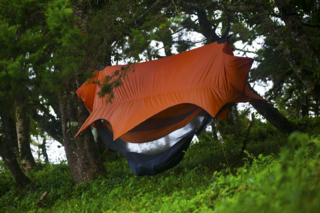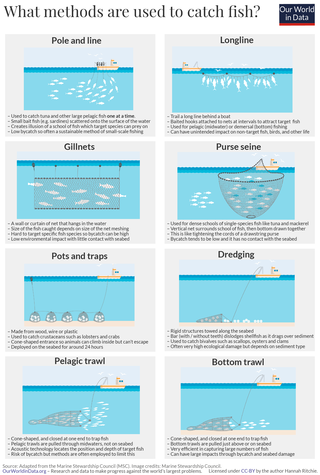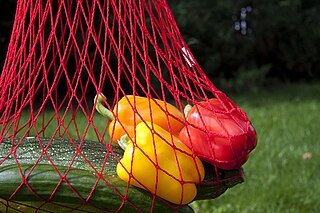
A hammock, from Spanish hamaca, borrowed from Taíno and Arawak hamaka, is a sling made of fabric, rope, or netting, suspended between two or more points, used for swinging, sleeping, or resting. It normally consists of one or more cloth panels, or a woven network of twine or thin rope stretched with ropes between two firm anchor points such as trees or posts. Hammocks were developed by native inhabitants of the Americas for sleeping, as well as the English. Later, they were used aboard ships by sailors to enable comfort and maximize available space, by explorers or soldiers travelling in wooded regions and eventually by parents in the early 1920s for containing babies just learning to crawl. Today they are popular around the world for relaxation; they are also used as a lightweight bed on camping trips. The hammock is often seen as a symbol of summer, leisure, relaxation and simple, easy living.

Webbing is a strong fabric woven as a flat strip or tube of varying width and fibres, often used in place of rope. It is a versatile component used in climbing, slacklining, furniture manufacturing, automobile safety, auto racing, towing, parachuting, military apparel, load securing, and many other fields.

Gillnetting is a fishing method that uses gillnets: vertical panels of netting that hang from a line with regularly spaced floaters that hold the line on the surface of the water. The floats are sometimes called "corks" and the line with corks is generally referred to as a "cork line." The line along the bottom of the panels is generally weighted. Traditionally this line has been weighted with lead and may be referred to as "lead line." A gillnet is normally set in a straight line. Gillnets can be characterized by mesh size, as well as colour and type of filament from which they are made. Fish may be caught by gillnets in three ways:
- Wedged – held by the mesh around the body.
- Gilled – held by mesh slipping behind the opercula.
- Tangled – held by teeth, spines, maxillaries, or other protrusions without the body penetrating the mesh.

A fishing net is a net used for fishing. Some fishing nets are also called fish traps, for example fyke nets. Fishing nets are usually meshes formed by knotting a relatively thin thread. Early nets were woven from grasses, flaxes and other fibrous plant material. Later cotton was used. Modern nets are usually made of artificial polyamides like nylon, although nets of organic polyamides such as wool or silk thread were common until recently and are still used.

Mist nets are used by hunters and poachers, but also by ornithologists and chiropterologists to capture wild birds and bats for banding or other research projects. Mist nets are typically made of nylon or polyester mesh suspended between two poles, resembling a volleyball net. When properly deployed in the correct habitat, the nets are virtually invisible. Mist nets have shelves created by horizontally strung lines that create a loose, baggy pocket. When a bird or bat hits the net, it falls into this pocket, where it becomes tangled.

A lobster trap or lobster pot is a portable trap that traps lobsters or crayfish and is used in lobster fishing. In Scotland, the word creel is used to refer to a device used to catch lobsters and other crustaceans. A lobster trap can hold several lobsters. Lobster traps can be constructed of wire and wood, metal and netting, or rigid plastic. An opening permits the lobster to enter a tunnel of netting or other one-way device. Pots are sometimes constructed in two parts, called the "chamber" or "kitchen", where there is bait, and exits into the "parlor", which prevents escape. Lobster pots are usually dropped to the sea floor, one or more at a time, sometimes up to 40 or more, and are marked by a buoy so they can be picked up later.

Seine fishing is a method of fishing that employs a surrounding net, called a seine, that hangs vertically in the water with its bottom edge held down by weights and its top edge buoyed by floats. Seine nets can be deployed from the shore as a beach seine, or from a boat.
Filet lace is the general word used for all the different techniques of embroidery on knotted net. It is a hand made needlework created by weaving or embroidery using a long blunt needle and a thread on a ground of knotted net lace or filet work made of square or diagonal meshes of the same sizes or of different sizes. Lacis uses the same technique but is made on a ground of leno or small canvas.

Cricket nets are used by batters and bowlers to practice their cricketing techniques. They consist of a cricket pitch enclosed by netting on either side, behind, and optionally above. The bowling end is left open.

Drift netting is a fishing technique where nets, called drift nets, hang vertically in the water column without being anchored to the bottom. The nets are kept vertical in the water by floats attached to a rope along the top of the net and weights attached to another rope along the bottom of the net. Drift nets generally rely on the entanglement properties of loosely affixed netting. Folds of loose netting, much like a window drapery, snag on a fish's tail and fins and wrap the fish up in loose netting as it struggles to escape. However, the nets can also function as gill nets if fish are captured when their gills get stuck in the net. The size of the mesh varies depending on the fish being targeted. These nets usually target schools of pelagic fish.

Fishing tackle is the equipment used by anglers when fishing. Almost any equipment or gear used in fishing can be called fishing tackle, examples being hooks, lines, baits/lures, rods, reels, floats, sinkers/feeders, nets, spears, gaffs and traps, as well as wires, snaps, beads, spoons, blades, spinners, clevises and tools that make it easy to tie knots.

Hammock camping is a form of camping in which a camper sleeps in a suspended hammock rather than a conventional tent on the ground. Due to the absence of poles and the reduced amount of material used, hammocks can be lighter than a tent, though this is not always the case. Most hammocks will also require less space in a pack than a similar occupancy tent. In foul weather, a tarp is suspended above the hammock to keep the rain off of the camper. Mosquito netting, sometimes integrated into the camping hammock itself, is also used as climatic conditions warrant. Camping hammocks are used by campers who are looking for lighter weight, protection from ground-dwelling insects, or other ground complications such as sloped ground, rocky terrain and flooded terrain.

A safety net is a net to protect people from injury after falling from heights by limiting the distance they fall, and deflecting to dissipate the impact energy. The term also refers to devices for arresting falling or flying objects for the safety of people beyond or below the net. Safety nets are used in construction, building maintenance, entertainment, or other industries.
The manufacture of textiles is one of the oldest of human technologies. To make textiles, the first requirement is a source of fiber from which a yarn can be made, primarily by spinning. The yarn is processed by knitting or weaving, which turns yarn into cloth. The machine used for weaving is the loom. For decoration, the process of colouring yarn or the finished material is dyeing. For more information of the various steps, see textile manufacturing.

Net or netting is any textile in which the yarns are fused, looped or knotted at their intersections, resulting in a fabric with open spaces between the yarns. Net has many uses, and comes in different varieties. Depending on the type of yarn or filament that is used to make up the textile, its characteristics can vary from durable to not durable.

Fishing techniques are methods for catching fish. The term may also be applied to methods for catching other aquatic animals such as molluscs and edible marine invertebrates.

A casting net, also called a throw net, is a net used for fishing. It is a circular net with small weights distributed around its edge.

A hand net, also called a scoop net, is a handheld fishing net or meshed basket used to capture and retrieve objects from water, somewhat in the manner of a sieve. It is distinguished from other fishing nets in that the net or mesh is supported by a rigid circular or polygonal frame, which may or may not be mounted to the end of a handle.

A string bag, net bag, or mesh bag is an open netted bag. Mesh bags are constructed from strands, yarns, or non-woven synthetic material into a net-like structure. String bags are used as reusable shopping bags and as packaging for produce.

String is a long flexible structure made from fibers twisted together into a single strand, or from multiple such strands which are in turn twisted together. String is used to tie, bind, or hang other objects. It is also used as a material to make things, such as textiles, and in arts and crafts. String is a simple tool, and its use by humans is known to have been developed tens of thousands of years ago. In Mesoamerica, for example, string was invented some 20,000 to 30,000 years ago, and was made by twisting plant fibers together. String may also be a component in other tools, and in devices as diverse as weapons, musical instruments, and toys.
























